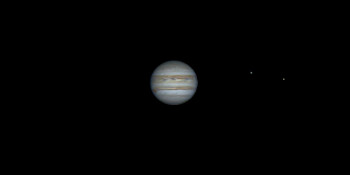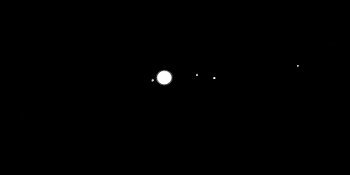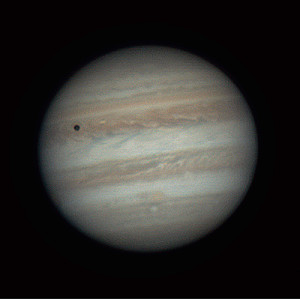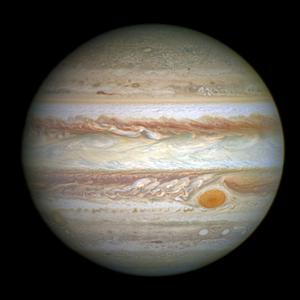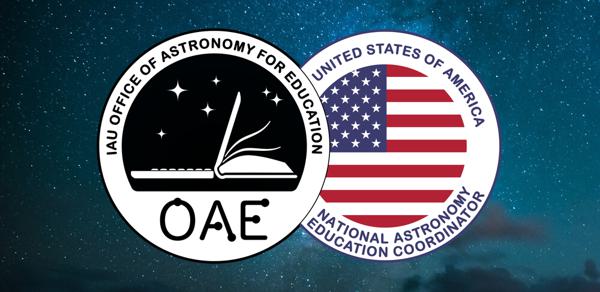Glossarbegriffe: Jupiter
Description: Jupiter ist der größte Planet im Sonnensystem und von der Sonne aus gesehen der fünfte Planet. Er ist ein Gasriese mit einem Radius von 71.300 Kilometern (km), was etwa dem 11-fachen Radius der Erde entspricht. Seine Masse (318-mal so groß wie die Masse der Erde) ist größer als die aller anderen Planeten und der kleineren Objekte im Sonnensystem zusammen. Sein deutscher Name leitet sich von der obersten römischen Gottheit ab.
Seine typische Entfernung von der Sonne beträgt 778 Mio. km, d. h. etwa 5 Astronomische Einheiten (Abstand Erde-Sonne). Jupiter braucht knapp 12 Jahre für einen Umlauf um die Sonne. Bis zum Jahr 2023 haben Astronomen mehr als 90 Monde oder natürliche Satelliten entdeckt, die Jupiter umkreisen.
Jupiter ist mit dem bloßen Auge sichtbar. In einem kleinen Teleskop können wir verschiedenfarbige Wolkenbänder und eine riesige rote, kreisförmige Sturmregion (den sogenannten Großen Roten Fleck) sehen. In den vergangenen Jahrzehnten wurden einige Raumsonden zum Jupiter geschickt. 2016 begann die NASA-Raumsonde Juno, den Jupiter und seine Monde genauer zu erforschen.
Zugehörige Glossarbegriffe:
- Astronomische Einheit
- Galileische Satelliten
- Gasriese
- Riesenplanet
- Großer Roter Fleck
- Äußere Planeten
- Planet
- Sonnensystem
See this term in other languages
Term and definition status: The original definition of this term in English have been approved by a research astronomer and a teacher The translation of this term and its definition is still awaiting approval
The OAE Multilingual Glossary is a project of the IAU Office of Astronomy for Education (OAE) in collaboration with the IAU Office of Astronomy Outreach (OAO). The terms and definitions were chosen, written and reviewed by a collective effort from the OAE, the OAE Centers and Nodes, the OAE National Astronomy Education Coordinators (NAECs) and other volunteers. You can find a full list of credits here. All glossary terms and their definitions are released under a Creative Commons CC BY-4.0 license and should be credited to "IAU OAE".
If you notice a factual or translation error in this glossary term or definition then please get in touch.
Zugehörige Medien
Jupiter's Rotation, by Vishal Sharma, India
Bildnachweis: Vishal Sharma/IAU OAE
License: CC-BY-4.0 Creative Commons Namensnennung 4.0 International (CC BY 4.0) icons
Jupiter Moons Movie2, by Nicolas Hurez, Paul-Antoine Matrangolo, and Carl Pennypacker, United States of America
Bildnachweis: Nicolas Hurez, Paul-Antoine Matrangolo and Carl Pennypacker/IAU OAE
License: CC-BY-4.0 Creative Commons Namensnennung 4.0 International (CC BY 4.0) icons
Jupiter, Io and its shadow, by Ralf Burkart, Germany
Bildnachweis: Ralf Burkart/IAU OAE
License: CC-BY-4.0 Creative Commons Namensnennung 4.0 International (CC BY 4.0) icons
Jupiter
Bildnachweis: NASA, ESA, and A. Simon (Goddard Space Flight Center) credit link
License: CC-BY-4.0 Creative Commons Namensnennung 4.0 International (CC BY 4.0) icons
Fließender Nachthimmel
Bildnachweis: Robert Barsa/IAU OAE
License: CC-BY-4.0 Creative Commons Namensnennung 4.0 International (CC BY 4.0) icons
